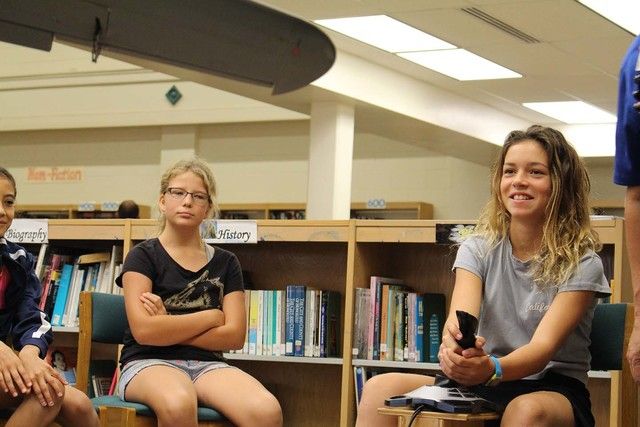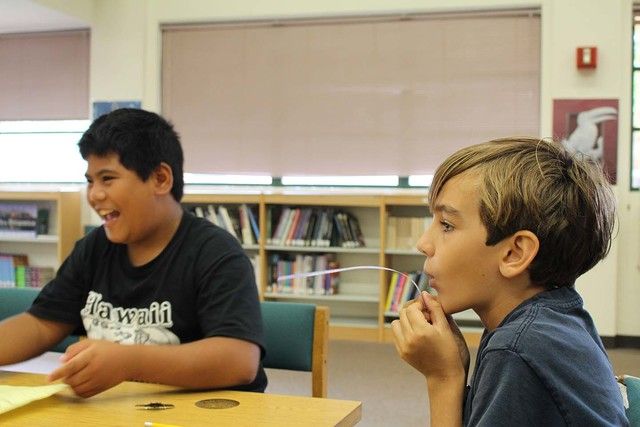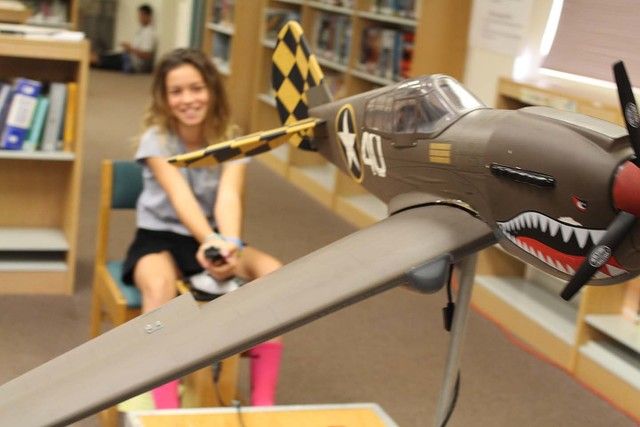KAPAA — Sophie Carswell grabbed the joystick on a flight simulator, smiled eagerly, and leaned forward. The Kilauea Elementary School sixth-grader was testing out a model World War II P-40 aircraft at the Kapaa Middle School using scientific concepts that
KAPAA — Sophie Carswell grabbed the joystick on a flight simulator, smiled eagerly, and leaned forward.
The Kilauea Elementary School sixth-grader was testing out a model World War II P-40 aircraft at the Kapaa Middle School using scientific concepts that she had just learned at the school’s library.
Expert barnstormer Ford Ebesugawa, in a shirt emblazoned with the Pacific Aviation Museum Pearl Harbor logo, directed the 11-year-old maneuvering the large model plane.
“OK, make your plane follow my plane,” he said as he held up a smaller version.
Carswell steered her plane while Ebesugawa taunted her with a miniature copy of the P-40 aircraft.
“Yawn to the left,” he shouted at her. “Roll to the right.”
The P-40 aircraft slowly jerked left or right, reacting to Sophie’s stick and pedal inputs.
At the end of her turn, Sophie gave up the flight simulator to the next student, smiled triumphantly and declared, “Maybe I’ll be a pilot.”
Carswell was one of 60 sixth-graders who learned about Bernoulli’s principle and Newton’s Third Law of Motion on Thursday.
It was all part of the Pacific Aviation Museum’s Barnstorming Program, intended to reach more than 600 public school sixth-graders on Kauai.
“It’s about as close as they are going to get to flying an airplane without actually putting something in the sky,” said Nick Kaan, barnstorming tour coordinator manager.
The program was developed in 2010, and is the product of a collaboration between the Pacific Aviation Museum and the University of Hawaii at Manoa. It has visited more than 210 Hawaiian schools and reached more than 18,000 sixth-graders.
“It’s five of us that go around on Oahu, but now we’re branching out, and it’s at no charge to the school,” Kaan said.
Stan May, barnstorming tour coordinator, said the term “barnstorming” refers to a style of stunt piloting that was performed in the 1920s to showcase pilots’ skills and the sturdiness of the planes they flew. Afterwards, they hid the planes near barns.
Kaan and his group uses the practice to teach kids about scientific flight principles in 75- to 90-minute presentations. At every presentation, the flight simulator for the World War II aircraft is the main attraction.
“When they come in, they see an airplane, they are like, ‘Awesome,’” Kaan said. “Some of the girls are like, ‘Blah.’ One of our focuses is to introduce the little girls to science and STEM studies. By the end of this, the girls will be smiling.”
The kids also learned other basic concepts such as lift and gravity, with hands-on experiments using cans, a wind tunnel, paper and ping-pong balls.
“It’s a type of science that students don’t get to experience in a normal setting,” Kaan said.
Beside the remote control P-40, the museum brought several other activities.
“Aviation plays such an important role in our everyday lives, from an economic and social point of view, to protecting our nation from harm,” said Shauna Tonkin, director of education at Pacific Aviation Museum Pearl Harbor.
Judy Waite, Kilauea Elementary teacher, said the program encourages hands-on learning.
“It had enough different experiments for the Bernoulli’s principles and Newton’s laws and the kids really understood it,” Waite said.
The program is funded by donations and grants.
Kauai Superintendent Bill Arakaki said the Barnstorming Tour provides an opportunity to apply and reinforce the relevance of what students are learning in the classroom related to science, technology, engineering and math.
“We are very thankful for this partnership in having this innovative program being shared and experienced with our Kauai students and schools,” he said.




